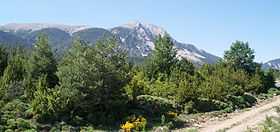Sierra de Guara
| Sierra de Guara | |
|---|---|
 | |
| Elevation | 2,077 m (6,814 ft) |
| Listing | Mountains of Aragon |
| Location | |
 Sierra de Guara | |
| Location | Alto Gállego, Hoya de Huesca, Aragon |
| Range | Pre-Pyrenees |
| Coordinates | 42°17′N 0°13′W / 42.283°N 0.217°WCoordinates: 42°17′N 0°13′W / 42.283°N 0.217°W |
| Geology | |
| Type | Limestone |
| Climbing | |
| Easiest route | From Huesca |
The Sierra de Guara is a mountain massif in the province of Huesca, the most northerly province in the autonomous community of Aragon, Spain. Its highest point is Tozal de Guara (2,077 m).
It lies around 25km northeast of the city of Huesca itself. Much of the massif is now included within a natural park known as the Parque de la Sierra y Cañones de Guara which extends 43km from west to east and 25km north to south. The Park includes, in addition to the Sierra de Guara itself, much of the Sierra de Gabardiella in the west and the Sierra de Arangol, Sierra de Balced, Sierra de Sebil and Sierra de Rufás in the east.
Landscape features
A number of rivers flow north-south through the area, the principal ones having their sources to the north of the massif and cutting through the massif by way of spectacular gorges such as those of the Rio Alcanadre, Rio Guatizalema, Rio Vero and Rio Isuala.[1] Each of these rivers ultimately drain into the Ebro.
Geology
The massif is formed mainly from Palaeogene limestone and, on its southern edge, an overlying coarse sandstone of Miocene age which is largely conglomeratic.[2]
Towns and villages
The area is sparsely populated with a number of abandoned villages within its interior. The villages of Alquézar and Rodellar have been reinvigorated in recent years by tourist development. To the northeast, outside of the natural park lies the historic city of Ainsa and to the south is Barbastro.
Sport and recreation
The area has become known in recent years for the considerable opportunities for canyoning in its many gorges. Rock climbing and caving are also practised whilst others enjoy walking and wildlife-watching.
See also
References
External links
| Wikimedia Commons has media related to Sierra de Guara. |